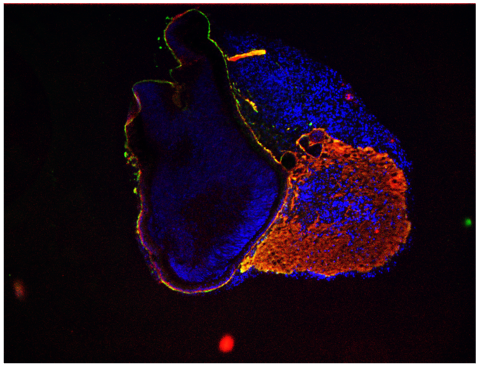Organoid production at IMS
Aurore Loeuillet, cell biology engineer.
What are organoids?
The term organoid means “organ-like”. Organoids are therefore tissues that mimic the development of an organ.
To obtain them, researchers cultivate human stem cells. At the IMS, cerebral organoids are produced, mimicking the primary development of a human brain.

Example of cerebral organoid after 70 days of development expressing markers of the extracellular matrix (Laminin in green) and its receptors (integrins in red).
Why is the purpose of doing research on organoids ?
As these organoids mimic brain development, it is interesting to study them in order to develop drugs for various diseases, including neurodegenerative diseases.
Researchers give organoids the drugs one would give to an individual. Organoids make it possible to test several conditions and molecules in parallel in a human tissue presenting a complexity approaching that of the organ. It is a real alternative to the use of mice for which ethical reasons limit testing and for which the transfer of results to humans may lack value.
How do you proceed to do the research ?
Stem cells are grown in 3D in a culture medium containing factors that promote organoid maturation. Different maturation stages are obtained, ranging from 20 to up to 200 days of culture for the latest stage of development tested at the IMS.
After these long periods of culture and maturation, the organoids are fixed and preserved for histological and molecular studies.
What do you hope to do with it / What will you do next?
The next step is to use it to test the effect of new drug candidates developed by IMS teams. A first priority is to check the absence of toxicity of these new compounds to ensure very quickly on the long road of the validation of a drug that these candidates have a chance of reaching the bed of patients.